

Constructivism. Summary: Constructivism as a paradigm or worldview posits that learning is an active, constructive process.
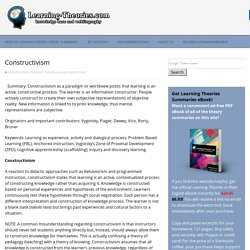
The learner is an information constructor. People actively construct or create their own subjective representations of objective reality. Math Forum - Constructivism in Mathematics Education. The Forum's Internet Mathematics Library provides a page of links to sites on Constructivism.
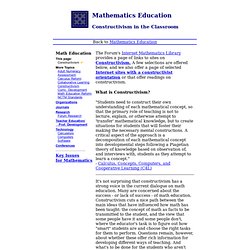
A few selections are offered below, and we also offer a page of selected Internet sites with a constructivist orientation or that offer readings on constructivism. What is Constructivism? "Students need to construct their own understanding of each mathematical concept, so that the primary role of teaching is not to lecture, explain, or otherwise attempt to 'transfer' mathematical knowledge, but to create situations for students that will foster their making the necessary mental constructions.
A critical aspect of the approach is a decomposition of each mathematical concept into developmental steps following a Piagetian theory of knowledge based on observation of, and interviews with, students as they attempt to learn a concept. " - Calculus, Concepts, Computers, and Cooperative Learning (C4L) It's not surprising that constructivism has a strong voice in the current dialogue on math education. Department of Education - Critical feature of numeracy teaching and learning.
Constructivist or inquiry approaches Constructivist approaches have proved to be effective in enhancing student learning.
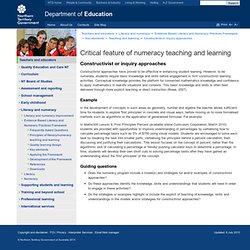
However, to be numerate, students require basic knowledge and skills before engagement in 'rich' constructivist learning activities. Conceptual knowledge provides the platform for connected mathematics knowledge and confidence to apply mathematics in real-life situations and contexts. This basic knowledge and skills is often best delivered through more explicit teaching or direct instruction (Rowe, 2007). Example In the development of concepts in such areas as geometry, number and algebra the teacher allows sufficient time for students to explore 'first principles' in concrete and visual ways, before moving on to more formalised methods such as algorithms or the application of generalised formulae.
Guiding questions. What Is a Constructivist Classroom? Imagination Soup Fun Learning and Play Activities for Kids. Constructivism by Swinburne Online on Prezi. Constructivism Learning Theory by Niki Hudson on Prezi. Constructivism by Cindy Andrews by Cindy Andrews on Prezi. Constructivism by Kylie Nikole on Prezi. Learning Theories. A Simple Guide To 4 Complex Learning Theories. Constructivism and the Student-Centered Approach. "When you make the finding yourself — even if you’re the last person on Earth to see the light — you’ll never forget it.
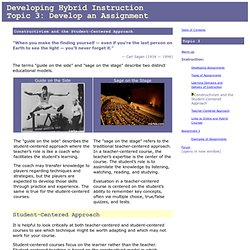
" The terms "guide on the side" and "sage on the stage" describe two distinct educational models. Student-Centered Approach It is helpful to look critically at both teacher-centered and student-centered courses to see which technique might be worth adapting and which may not work for your course. Student-centered courses focus on the learner rather than the teacher. Student-centered teaching is based on the constructivist model in which students construct rather than receive or assimilate knowledge. In "The Virtual Classroom: Learning Without Limits Via Computer Networks," Roxanne Star Hiltz describes the student-centered constructivist model of teaching: "Constructivist learning models require active input from students and requires intellectual effort and aids retention.
Example: Eleven facts about a banana. Constructivism (philosophy of education) Jean Piaget: founder of Constructivism In past centuries, constructivist ideas were not widely valued due to the perception that children's play was seen as aimless and of little importance.

Jean Piaget did not agree with these traditional views, however. He saw play as an important and necessary part of the student's cognitive development and provided scientific evidence for his views. Today, constructivist theories are influential throughout much of the non-formal learning sector. One good example of constructivist learning in a non-formal setting is the Investigate Centre at The Natural History Museum, London. For more detailed information on the philosophy of the construction of human knowledge, see constructivist epistemology. Constructivism and the Student-Centered Approach. June. Due to Khan Academy’s popularity, the idea of the flipped classroom has gained press and credibility within education circles.
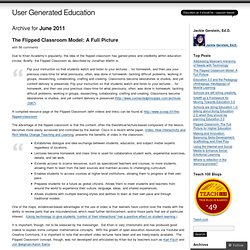
Briefly, the Flipped Classroom as described by Jonathan Martin is: Flip your instruction so that students watch and listen to your lectures… for homework, and then use your precious class-time for what previously, often, was done in homework: tackling difficult problems, working in groups, researching, collaborating, crafting and creating. Classrooms become laboratories or studios, and yet content delivery is preserved. Flip your instruction so that students watch and listen to your lectures… for homework, and then use your precious class-time for what previously, often, was done in homework: tackling difficult problems, working in groups, researching, collaborating, crafting and creating. Classrooms become laboratories or studios, and yet content delivery is preserved ( A compiled resource page of the Flipped Classroom (with videos and links) can be found at. THE BRAIN FROM TOP TO BOTTOM. Learning theory: models, product and process.
Photo by Antenna on Unsplash Contents: introduction · what do people think learning is?
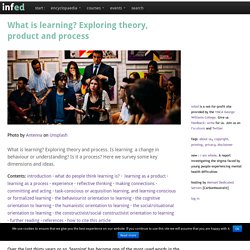
· learning as a product · learning as a process · experience · reflective thinking · making connections · committing and acting · task-conscious or acquisition learning, and learning-conscious or formalized learning · the behaviourist orientation to learning · the cognitive orientation to learning · the humanistic orientation to learning · the social/situational orientation to learning · the constructivist/social constructivist orientation to learning · further reading · references · how to cite this article See, also, What is education? Over the last thirty years or so, ‘learning’ has become one of the most used words in the field of education. Constructivist Learning Theory. Teaching with the Constructivist Learning Theory What is the best method of teaching to use?
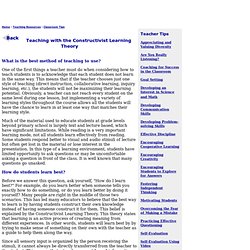
One of the first things a teacher must do when considering how to teach students is to acknowledge that each student does not learn in the same way. This means that if the teacher chooses just one style of teaching (direct instruction, collaborative learning, inquiry learning, etc.), the students will not be maximizing their learning potential.
Obviously, a teacher can not reach every student on the same level during one lesson, but implementing a variety of learning styles throughout the course allows all the students will have the chance to learn in at least one way that matches their learning style. Much of the material used to educate students at grade levels beyond primary school is largely text and lecture based, which have significant limitations. How do students learn best? Before we answer this question, ask yourself, "How do I learn best? " Constructivist Teaching Methods. Learning Theories. Teaching Instructivist Educated Digital Natives Using a Constructivist Learning Theory in Transnational Education. Assessment in a Constructivist, Technology-Supported Learning 2 by Willan Keith Badidles on Prezi.
Constructivist Learning Theory. The Museum and the Needs of People CECA (International Committee of Museum Educators) Conference Jerusalem Israel, 15-22 October 1991 Prof.
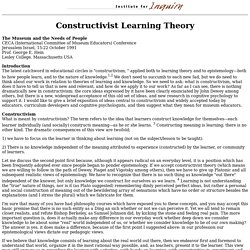
George E. Hein Lesley College. Massachusetts USA.